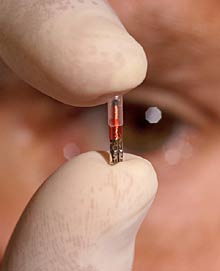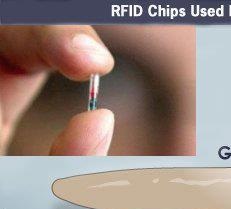31 Jul 2014
The RFID implanting scare, and an incorrect comparison in the Snopes.com analysis.
** Before implying anything about Snopes.com from the title, please note that I refer to Snopes.com often and find their information to be quite useful for a quick comparison of what I am reading against known facts. They are not the final source of information for me, but have proven to always be a good starting point.
This article notes a very specific inaccuracy, and I only publish it here to emphasize the importance of criticial thinking with every source of information. I think anyone running a site like snopes.com, which undoubtedly deals with a near flood of rumors to investigate and document, would have potentially overlooked what I am documenting here. **
Back in July of 2013, snopes.com posted an article about an end-times email scare. The scare was a strange mix of misinformation about the health care law, combined with claims about radio-frequency identification (RFID) implanted chips mentioned in a broadcast NBC report. As the snopes.com article correctly shows, those claims weren’t really there in the NBC report, nor was there any such language in the health care law.
The original article is here. I only recently found the article, because the email finally made its rounds into my inbox.
So what’s inaccurate in the snopes.com article? The snopes.com article contains a snapshot of the original photo of the RFID chip which appeared in the email mentioned (image to the right below), and also has a link to the product page which Snope’s claims is the RFID chip in the email (image to the left). I’ve put them side-by-side below for comparison.
 Snopes (from medgadget.com) |
 Emailed |
The snopes.com article claims the chip pictured in the email is the same as in this article. The exact quote from snopes.com is the following:
I disagree with Snopes’ conclusion for the following reasons:
#1: The person in the image isn’t simply altered with photoshop to blur out the face in one picture. There are a lot of things different between the two people.
- The position of the finger above the eye is blocking two different portions of the eye in each picture.
- The photo in the email cannot be a cropped version of the original photo in the medgadget.com article because you have to have something to crop. Notice that the view in the email photo from left to right shows more facial area than the photo in medgadget.com, which it is supposedly copied from. Cropping shows a smaller area of a larger photo, not the other way around. There is no nose in the medgadget.com photo to copy.
- The fingers in the email photo show skin and fingernails: in other words, it is a bare hand. The fingers in the medgadget.com photo are wearing latex gloves.
#2: The chips in the pictures are clearly different. Note the following differences.
- The medgadget.com photo shows brass-colored sensors at the end of the chip (bottom). The email photo does not have them; it is a solid clear shell. This makes sense since a glucose measuring chip needs sensors on the outside to make contact with the fluids to measure them. An RFID chip does not need external sensors: it is not measuring anything.
- The medgadget.com photo shows a thicker shell on the top half of the chip, while the the email photo does not have this.
The chip in the email is a Verichip product, based on a Destron device available since the 90’s. The product slip for it is here. This chip has extensive use in research laboratories for identifying animals in experiments, and is a major advance for this industry. Prior to implantable RF identification, mice chewing off an ear with a tag could ruin days or weeks of research efforts if the animal could not be identified. It also allowed the identification number to be read directly into the notebook/laptop by waving a wand over the animal (no danger of invalid number entry from a human interface like a keyboard).
The device pictured in the email is similar to the device at the top left on the product slip: there are no external sensors on an identification responder. Functionally, the chip in the email and in this product slip is similar to the automated highway toll paying device in your car. When a transmitter at the top of a toll-booth gets close enough to the device in your car when you pass under it, the device in your car transmits its identification number in response. That is all it does.
Any other conclusions about the purpose of the device in humans, whether it is the mark of the beast, etc, are up to you. I am merely pointing out that the chip in the email is not the chip which Snopes.com claims it is.
(original NBC video mentioned in the email)
Leave a Comment
You must be logged in to post a comment.



